- Clone
- 1H9 (See other available formats)
- Regulatory Status
- RUO
- Other Names
- Paired box 5, B-cell lineage specific activator, BSAP, paired box homeotic gene 5
- Isotype
- Rat IgG2a, κ
- Barcode Sequence
- TTCTTCAGTAGTACC
- Ave. Rating
- Submit a Review
- Product Citations
- publications
| Cat # | Size | Price | Quantity Check Availability | Save | ||
|---|---|---|---|---|---|---|
| 649713 | 10 µg | 296€ | ||||
Pax5, also known as BSAP (B cell specific activator protein), is a member of the paired box (Pax) family of transcription factors. PAX proteins are important regulators in early development, and alterations in the expression of their genes are thought to contribute to neoplastic transformation. Pax5 is the only member of the Pax family of transcription factors that is expressed in hematopoietic cells. During embryogenesis, Pax5 is transiently expressed in the brain of mice and in the mesencephalon and spinal cord of humans. Its expression is upregulated early in B cell development at the time of B cell commitment and is maintained throughout most subsequent stages. Suppression of Pax5 is essential for expression of Blimp-1 and the terminal differentiation of plasma cells. In the spleen, expression of Pax5 is higher in marginal zone B cells (B220+ CD21high CD23low) than in other B cells, especially the transition 1 stage (B220+ CD21- CD23-). In addition to its role in B cell development, Pax5 also affects VH-DJH heavy chain recombination as well as influencing the expression of many other B and non-B cell related proteins. Its expression has also been detected in developing CNS and testis and so the encoded protein may also play a role in neural development and spermatogenesis.
This gene is located at 9p13, which is involved in t(9;14)(p13;q32) translocations recurring in small lymphocytic lymphomas of the plasmacytoid subtype, and in derived large-cell lymphomas. This translocation brings the potent E-mu enhancer of the IgH gene into close proximity of the PAX5 promoter, suggesting that the deregulation of transcription of this gene contributes to the pathogenesis of these lymphomas. Alternatively spliced transcript variants encoding different isoforms have been described but their biological validity has not been determined.
Product Details
- Verified Reactivity
- Human, Mouse
- Antibody Type
- Monoclonal
- Host Species
- Rat
- Immunogen
- Recombinant mouse Pax-5 protein
- Formulation
- Phosphate-buffered solution, pH 7.2, containing 0.09% sodium azide and EDTA
- Preparation
- The antibody was purified by chromatography and conjugated with TotalSeq™-Bn oligomer under optimal conditions.
- Concentration
- 0.5 mg/mL
- Storage & Handling
- The antibody solution should be stored undiluted between 2°C and 8°C. Do not freeze.
- Application
-
SB - Quality tested
- Recommended Usage
-
Each lot of this antibody is quality control tested by immunofluorescent staining in formalin-fixed, paraffin-embedded (FFPE) lymphoid tissue, and the oligomer sequence is confirmed by sequencing. TotalSeq™-Bn antibodies are compatible with the 10x Visium CytAssist Gene and Protein Expression Assay.
To maximize performance, it is strongly recommended that the reagent be titrated for each application, and that you centrifuge the antibody dilution at 14,000xg at 2 − 8°C for 10 minutes before use. Carefully pipette out the liquid avoiding the bottom of the tube when handling. To determine and optimize dilutions for the addition of Totalseq™-Bn antibodies into pre-designed antibody panels, refer to 10x Genomics Custom Add-on Antibody Optimization guide.
Buyer is solely responsible for determining whether Buyer has all intellectual property rights that are necessary for Buyer's intended uses of the BioLegend TotalSeq™ products. For example, for any technology platform Buyer uses with TotalSeq™, it is Buyer's sole responsibility to determine whether it has all necessary third party intellectual property rights to use that platform and TotalSeq™ with that platform. - Application Notes
-
The monoclonal 1H9 antibody recognizes both mouse and human Pax5.
Additional reported applications (for the relevant formats) include: Western blotting1,2, immunohistochemical staining of formalin-fixed sections, and spatial biology (IBEX)4,5.NOTE: For flow cytometric staining with this clone, True-Nuclear™ Transcription Factor Buffer Set (Cat. No. 424401) offers improved staining and is highly recommended over the Foxp3 Fix/Perm Buffer Set (Cat. No. 421403) and the Nuclear Factor Fixation and Permeabilization Buffer Set (Cat. No. 422601).
- Additional Product Notes
-
TotalSeq™-Bn reagents are designed to profile protein levels following an optimized protocol in spatial transcriptomics. Compatible spatial biology devices (e.g. Imaging System, 10x Genomics Visium Spatial CytAssist Gene and Protein Expression instruments and reagents) and sequencer (e.g. Illumina analyzers) are required. TotalSeq™-B reagents are not compatible with the 10x Genomics Visium system. The complete barcode sequence may be provided upon request. Please contact technical support for more information, or visit TotalSeq™-Bn Reagents for 10x Genomics Visium CytAssist Gene and Protein Assay.
-
Application References
(PubMed link indicates BioLegend citation) - RRID
-
AB_3083225 (BioLegend Cat. No. 649713)
Antigen Details
- Structure
- 391 amino acids with predicted molecular weight of 42 kD
- Distribution
-
Nucleus
- Function
- Plays an important role in B-cell differentiation as well as neural development and spermatogenesis; involved in the regulation of the CD19 gene, a B-lymphoid-specific target gene
- Interaction
- Interacts with DAXX; binds DNA as a monomer, binds TLE4
- Cell Type
- B cells
- Biology Area
- Cell Biology, Immunology, Transcription Factors
- Molecular Family
- Nuclear Markers
- Antigen References
-
1. Liao F, et al. 1992. J. Immunol. 148:2909.
2. Nutt SL, et al. 1997. Genes Dev. 11:476.
3. Nera KP, et al. 2006. Immunity 24:283.
4. Fuxa M, et al. 2007. Immunity 178:3031. - Gene ID
- 5079 View all products for this Gene ID
- UniProt
- View information about Pax-5 on UniProt.org
Related Pages & Pathways
Pages
Related FAQs
- If an antibody clone has been previously successfully used in IBEX in one fluorescent format, will other antibody formats work as well?
-
It’s likely that other fluorophore conjugates to the same antibody clone will also be compatible with IBEX using the same sample fixation procedure. Ultimately a directly conjugated antibody’s utility in fluorescent imaging and IBEX may be specific to the sample and microscope being used in the experiment. Some antibody clone conjugates may perform better than others due to performance differences in non-specific binding, fluorophore brightness, and other biochemical properties unique to that conjugate.
- Will antibodies my lab is already using for fluorescent or chromogenic IHC work in IBEX?
-
Fundamentally, IBEX as a technique that works much in the same way as single antibody panels or single marker IF/IHC. If you’re already successfully using an antibody clone on a sample of interest, it is likely that clone will have utility in IBEX. It is expected some optimization and testing of different antibody fluorophore conjugates will be required to find a suitable format; however, legacy microscopy techniques like chromogenic IHC on fixed or frozen tissue is an excellent place to start looking for useful antibodies.
- Are other fluorophores compatible with IBEX?
-
Over 18 fluorescent formats have been screened for use in IBEX, however, it is likely that other fluorophores are able to be rapidly bleached in IBEX. If a fluorophore format is already suitable for your imaging platform it can be tested for compatibility in IBEX.
- The same antibody works in one tissue type but not another. What is happening?
-
Differences in tissue properties may impact both the ability of an antibody to bind its target specifically and impact the ability of a specific fluorophore conjugate to overcome the background fluorescent signal in a given tissue. Secondary stains, as well as testing multiple fluorescent conjugates of the same clone, may help to troubleshoot challenging targets or tissues. Using a reference control tissue may also give confidence in the specificity of your staining.
- How can I be sure the staining I’m seeing in my tissue is real?
-
In general, best practices for validating an antibody in traditional chromogenic or fluorescent IHC are applicable to IBEX. Please reference the Nature Methods review on antibody based multiplexed imaging for resources on validating antibodies for IBEX.
Other Formats
View All Pax-5 Reagents Request Custom Conjugation| Description | Clone | Applications |
|---|---|---|
| Purified anti-Pax-5 | 1H9 | WB,ICC,IHC-P |
| Alexa Fluor® 647 anti-Pax-5 | 1H9 | ICFC,SB |
| Alexa Fluor® 488 anti-Pax-5 | 1H9 | ICFC |
| PE anti-Pax-5 | 1H9 | ICFC |
| PerCP/Cyanine5.5 anti-Pax-5 | 1H9 | ICFC |
| Alexa Fluor® 594 anti-Pax-5 | 1H9 | ICC |
| TotalSeq™-Bn1223 anti-Pax-5 | 1H9 | SB |
| TotalSeq™-B1223 anti-Pax-5 Antibody | 1H9 | ICPG |
Compare Data Across All Formats
This data display is provided for general comparisons between formats.
Your actual data may vary due to variations in samples, target cells, instruments and their settings, staining conditions, and other factors.
If you need assistance with selecting the best format contact our expert technical support team.
-
Purified anti-Pax-5
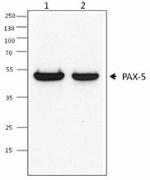
Western blot analysis of Daudi (lane 1) and A20 (lane 2) cel... 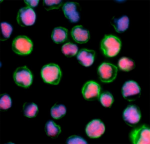
Ramos cells were fixed with 4% paraformaldehyde (PFA) for te... 
Tissue from human tonsil sections was fixed in 10% buffered ... -
Alexa Fluor® 647 anti-Pax-5
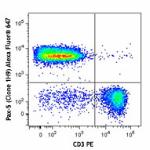
C57BL/6 mouse splenocytes were surface stained with mouse CD... 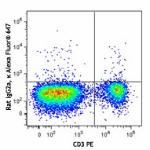
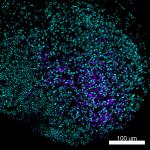
Mice were injected subcutaneously with sheep red blood cells... -
Alexa Fluor® 488 anti-Pax-5

C57BL/6 mouse splenocytes were surface stained with mouse CD... 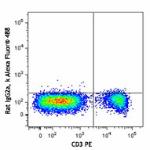
-
PE anti-Pax-5
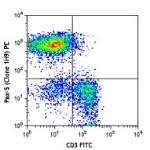
C57BL/6 mouse splenocytes were surface stained with mouse CD... 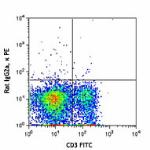
-
PerCP/Cyanine5.5 anti-Pax-5

C57BL/6 mouse splenocytes were stained with mouse CD3 APC th... -
Alexa Fluor® 594 anti-Pax-5

Daudi cells were fixed with 4% paraformaldehyde (PFA) for 10... -
TotalSeq™-Bn1223 anti-Pax-5
-
TotalSeq™-B1223 anti-Pax-5 Antibody
 Login / Register
Login / Register 












Follow Us